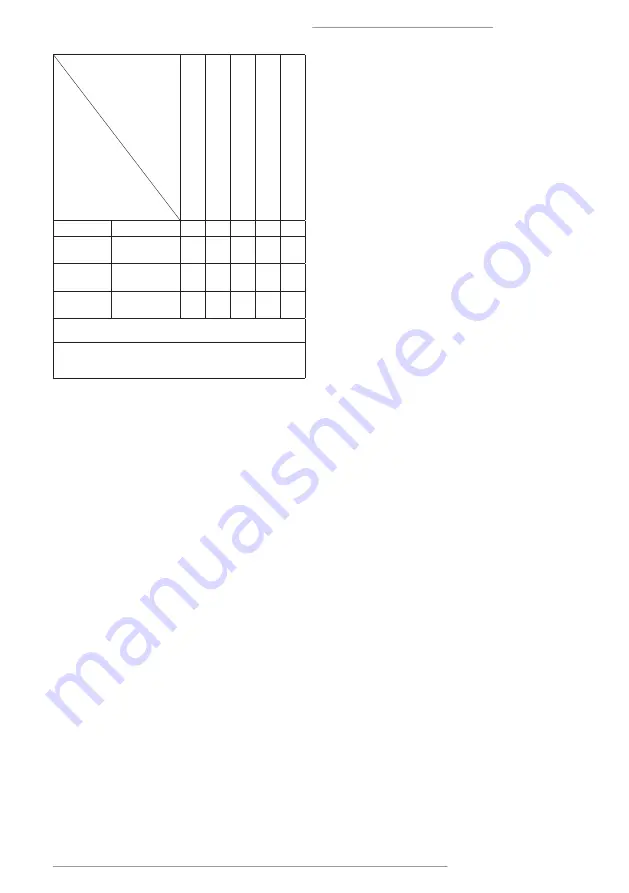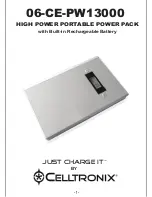
English |
9
www.ffgroup-tools.com
GVE 174 N1 PLUS | GVE 200 N1 PRO | GVE 200 N2 PRO
Items
B
ef
or
e e
ac
h u
se
A
ft
er 1
st m
on
th o
r fi
rs
t 2
0h
rs o
f o
pe
ra
ti
on
Ev
er
y 3 m
on
th
s o
r 5
0h
rs o
f o
pe
ra
ti
on
Ev
er
y 1
2 m
on
th
s o
r 1
00
hr
s o
f o
pe
r
at
io
n
Ev
er
y 2
4 m
on
th
s o
r 2
50
hr
s o
f o
pe
r
at
io
n
Fuel tank
Check-Clean **
√*
Deposit cup
(if available)
Clean
√
√
Valve clear
ance
Check-Ad
just **
√
Combustion
chamber
Check-Clean **
√*
*These items should be replaced if needed.
**These operations should be carried out only by authorised
dealer, that have the appropriate tools and the required
mechanical proficiency.
ENGINE OIL
WARNING:
Checking the level and changing the oil
should be done in solid and level ground. The engine
has to be stopped at all times. If the engine had been
running, it will be hot and the procedure should be
done with care in order to avoid burn danger.
To check the oil level:
1. Remove the oil filler cap.
2. Wipe the oil dipstick clean.
3. Insert the oil dipstick into the oil filler neck,
without screwing it.
4. Remove the oil dipstick and check the oil level
shown on it. If required, fill with oil to the upper
level.
5. Place the oil dipstick in position and tighten
appropriately.
To change the oil:
NOTE:
Drain the used oil while the engine is warm.
Warm oil drains quickly and completely.
WARNING:
Take necessary protective measures
against hot oil to avoid any danger of burn.
1. Remove the oil filler cap.
2.
Place a suitable container next to the engine to
catch the used oil.
3. Tilt the engine on its right side. The used oil will
drain through the filler neck. Allow the oil to
drain completely.
NOTE:
Dispose used motor oil and the containers in
a manner that is compatible with the environment.
We suggest you take it in a sealed container to your
local recycling center or service station for recla
mation. Do not throw it in the trash, pour it on the
ground, or pour it down a drain.
4. Reposition the engine on a level position.
5. Fill the engine with the recommended oil.
6. Allow a couple of moments for the oil to settle
in the engine and then measure the oil level us
Frequency
ing the oil dipstick. Repeat steps number 5 and
6 until the oil level is correct.
7. Place the oil filler cap in position and tighten
appropriately.
WARNING:
Running the engine will low oil level will
cause engine damage.
NOTE:
If the engine frequently works under dusty
or other severe circumstances, change the engine oil
every 10 hours.
AIR FILTER
WARNING:
Operating the engine without an air
cleaner, or with a damaged air cleaner, will allow dirt
to enter the engine, causing rapid engine wear.
1. Remove the air filter cover (Fig. 7.2).
2. Make sure that the air filter (Fig. 7.1) is free
from dirt and in a good condition.
f
To clean a foam air filter element wash it with
home detergent and hot water and let it dry. Then
soak it in clean saturated engine oil and gently
squeeze out excess oil. If required, re place it with
a new one.
f
To clean a paper air filter element, clean light dirt
by gently taping it a few times on a hard surface
and replace if heavy dirt is present.
3. Clean the inside of the air filter case and cov-
er from dirt with a soft cloth. If the engine is
equipped with an oil bath type air filter, replace
the oil with new engine oil.
4. Reinstall the air filter element and follow the
reverse procedure to put back in position the
air filter cover.
NOTE:
If the engine frequently works under dusty
or other severe circumstances, clean the air filter el
ement every 10 hours. If necessary, change the air
filter element every 25 hours.
SPARK PLUG
To maintain the spark plug:
1. Remove the spark plug cap to access the spark
plug.
2. Use an appropriate spark plug tool to carefully
remove the spark plug.
3. Inspect the condition of the spark plug and
its electrode. It must be clean and not worn.
Check that the spark plug gap is between 0.7
and 0.8mm (Fig. 8). Replace the spark plug with
a new one, if needed.
4. Carefully thread the spark plug into the engine
by hand.
5. Once threaded, use the appropriate spark plug
tool to tighten the spark plug, paying atten
tion not to use excessive force damaging the
threads.
6. Re-attach the spark plug cap.
WARNING:
Never allow dirt or debris to enter the
cylinder bore. Before removing the spark plug, thor
oughly clean the spark plug and cylinder head area.
FUEL SEDIMENT CUP
WARNING:
Maintain the fuel carburetor only outdoors and in
well ventilated areas.
To maintain the fuel sediment cup:
1. Turn the fuel valve to the “OFF” position.
Summary of Contents for GVE 174 N1 PLUS
Page 3: ...3 www ffgroup tools com GVE 174 N1 PLUS GVE 200 N1 PRO GVE 200 N2 PRO 4 7 5 6 8 1 1 2 1 2...
Page 22: ...22 GVE 174 N1 PLUS GVE 200 N1 PRO GVE 200 N2 PRO f f f f f f f 26...
Page 62: ...62 GVE 174 N1 PLUS GVE 200 N1 PRO GVE 200 N2 PRO...
Page 63: ...63 www ffgroup tools com GVE 174 N1 PLUS GVE 200 N1 PRO GVE 200 N2 PRO...










































